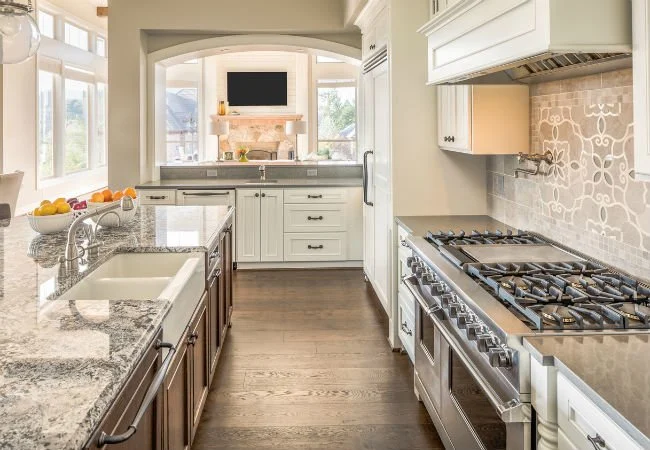Finding the ideal kitchen flooring requires striking a balance between style, function and comfort. Look for materials that can withstand heat, moisture and staining for best results.
Ceramic tile boasts an earthy appearance and can be stained in various styles to achieve its ideal natural aesthetic, while vinyl can mimic wood or stone textures for an authentic appearance.
Durability
Kitchen floors must withstand spills, heavy foot traffic and regular cleaning as well as moisture, steam and humidity levels. There are a number of flooring solutions that meet these criteria such as concrete, laminate, LVT or vinyl roll flooring options.
Linoleum flooring can also be an eco-friendly and long-term choice for kitchens. It features a water-repellant surface that resists damage from spilled liquid, yet remains easily slippery if overly wet. Although, linoleum may not look as pleasing aesthetically.
Natural stone flooring is another popular choice for kitchens, offering a distinctive and luxurious aesthetic while increasing home values. However, natural stone can be expensive to maintain as well as cold underfoot. Ceramic tile may offer a suitable alternative due to its wide array of colors and patterns which emulate similar looks found elsewhere such as wood or stone floors.
Style
Tile flooring is a popular kitchen choice due to its durability, water-resistance and wide variety of designs that complement virtually every interior design theme. Furthermore, it’s relatively affordable and installation requires little experience making it suitable for DIYers with limited experience.
Cork is an eco-friendly material with soft underfoot cushions that also provides durability. This makes it a great choice if you spend most of your time standing up in the kitchen as it won’t leave your feet stiff after long hours of standing on it.
Wood flooring remains a timeless classic for many homes, but its moisture absorption may make it less desirable than engineered wood products like LVT and vinyl roll. Engineered wood is often the superior option, as it doesn’t expand and contract as significantly when exposed to temperature variations or steam, plus it is less expensive than natural hardwood. One downside with engineered wood products may be difficult refinishing in future which should be kept in mind if selling your home in the future.
Maintenance
Hardwood floors are an iconic choice in kitchens. Not only can they add an elegant, warm appearance that can easily be updated via refinishing, they are also extremely durable and moisture resistant – yet vulnerable to being scratched or gouged from sharp items dropped onto them, as well as being susceptible to water damage.
Bamboo flooring offers an ideal alternative to hardwood, as its moisture and stain-resistant qualities and beautiful finishes make it more practical than its hardwood counterpart. Plus, bamboo comes in more colors and styles compared to hardwood.
Vinyl tile is an economical and sturdy choice that can resemble high-end materials like stone or hardwood, while remaining scratch-resistant and easy to maintain – two key characteristics ideal for kitchen use. Luxury vinyl plank (LVP), similarly, comes in wood grain design that mimics natural materials – while waterproof properties make this the ideal solution.
Budget
Even on a tight budget, there are flooring solutions that will work perfectly in your kitchen. Vinyl (not your grandparents’ vinyl!) and linoleum offer durable designs to fit different styles; both materials also resist spills and stains well.
Engineered wood is an economical alternative to natural hardwood that’s moisture resistant and easily refinished multiple times over the years, providing a solid wood replacement that won’t expand and contract in response to changes in temperature and moisture – potentially leading to water damage and ruin.
Cork flooring offers an affordable option with soft feel underfoot that makes working in the kitchen less tiring on your feet. Not only is it eco-friendly and fashionable, it can even be styled to mimic hardwood or tile – increasing its versatility further!







More Stories
The Ultimate Guide to Sustainable Flooring Options in 2025
10 Creative DIY Flooring Ideas That Will Transform Your Space
What Floor Tile is Best for Your Project?